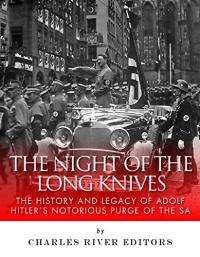
The Night of the Long Knives: The History and Legacy of Adolf Hitler's Notorious Purge of the SA
Germany's Nazi Party was remarkably implacable in the hostility it showed to the outside world, staunchly opposing both Communism and liberal democracy from the moment of its inception to that of its violent dissolution. The Nazis likewise showed steely, unwavering resolve in their lethal hatred of the Jews, the Slavs, and many others whom they labeled as "untermenschen," subhumans unworthy of rights, cultural standing, or life itself. They pursued their dark vision of "Aryan" superiority with a terrifying clarity and zeal, and they were willing to incur the enmity of the entire world in the process.
At the same time, despite this fanatic dedication to their overall vision, the Nazis had their own share of factional strife, and perhaps not surprisingly, the internecine struggle often led to violence, executions, and assassinations, byproducts of a totalitarian environment in which power appeared in its most undisguised and aggressive form. The firing squad, the bomb, the torture chamber, the extermination camp, the crematorium, and the noose of piano wire took the place of debate and persuasion in Hitler's Germany.
Like other totalitarian regimes, the leader of the Nazis kept an iron grip on power in part by making sure nobody else could attain too much of it, leading to purges of high-ranking officials in the Nazi party. Of these purges, the most notorious was the Night of the Long Knives, a purge in the summer of 1934 that came about when Hitler ordered the surprise executions of several dozen leaders of the SA. This fanatically National Socialist paramilitary organization had been a key instrument in overthrowing democratic government in Germany and raising Hitler to dictatorial power in the first place. However, the SA was an arm of the Nazi phenomenon which had socialist leanings and which was the private army of Ernst Röhm, which was enough for Hitler to consider the organization dangerous. Röhm was a challenger to the Fuhrer's position with his mushrooming SA ranks, which were more loyal to him than to the nominal head of Nazi Germany.
Though the SA as a whole survived Hitler's purge, its star was eclipsed by the rise of the newly favored Schutzstaffel (SS), which was instrumental in implementing the Night of the Long Knives. Additionally, the SA's senior leadership was decimated, leading to a loss of cohesion and focus. Even its overall commander, Ernst Röhm, fell victim to Hitler's violence, and Hitler himself later spoke words which summed up the calculated ruthlessness he used to deal with his enemies, both domestic and foreign: “The victor will not be asked afterwards whether he told the truth or not. When starting and waging war it is not right that matters, but victory. Close your hearts to pity. Act brutally.”
Several other factions were also involved. The German Army, or Reichswehr, was theoretically limited to a total of 100,000 men by the treaties ending World War I, but the German military was one of the major keys to power. Röhm dreamed of subsuming it totally into the SA, a nightmare from the point of view of the highly conservative and aristocratic officer corps. A man who championed the cause of the Reichswehr and kept it free of subordination to the SA could likely win its loyalty for years to come regardless of his own political and cultural agenda, which Hitler managed to accomplish with the purge.
The Night of the Long Knives chronicles the history of the Nazis’ most notorious purge. Along with pictures of important people, places, and events, you will learn about the Night of the Long Knives like never before, in no time at all.

